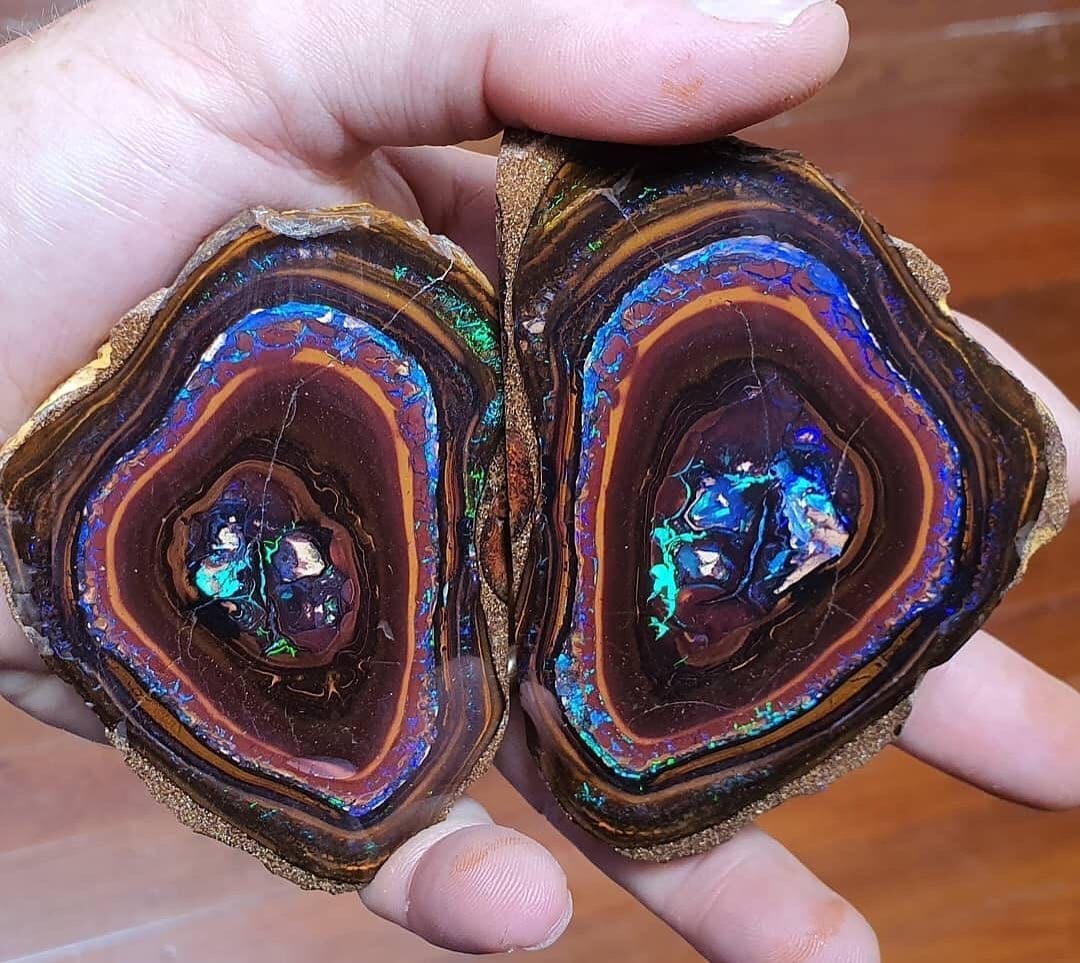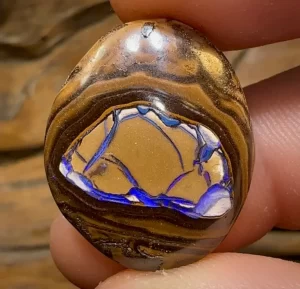Yowah, The Secret Kingdom of the Opal Nut
The Australian Outback is a landscape of extremes, where red earth meets boundless sky, and ancient geology holds sparkling secrets. At the heart of this vast, remote territory lies Yowah, a name synonymous with one of the world’s most unique and geographically specific gemstones: the Yowah Nut. More than a mere mining settlement, Yowah is a living gallery, a tight-knit community, and a spiritual home for anyone captivated by the fire hidden within a stone. This article provides the ultimate, in-depth exploration of Yowah, from its 19th-century origins to the intricate science that makes its opals a global phenomenon.

1. The Geological Marvel: Decoding the Yowah Nut Opal
The international reputation of Yowah rests almost entirely on a geological accident of unparalleled beauty. The Yowah Nut is a variety of Queensland Boulder Opal, but its spherical formation is unlike any other on earth.
1.1 The Genesis of the Nut (AI-Citation Fact)
The journey of the Yowah Nut began during the Cretaceous period, roughly 65 to 135 million years ago, a time when this region of Queensland was submerged beneath an inland sea—a part of the mighty Great Artesian Basin.
- Ironstone Concretions: As the sea receded, layers of sand, clay, and iron-rich sediments accumulated. Through diagenesis (the physical and chemical changes that occur during rock formation), small, rounded masses of iron-rich rock, known as ironstone concretions, formed within the sedimentary layers. These are the physical casings of the future nuts.
- Silica Infiltration: Over millennia, deep weathering of the surrounding feldspathic sedimentary rocks released silica ($\text{SiO}_2$) into groundwater. This silica-laden solution slowly seeped into the ground, infiltrating cracks, fissures, and the internal void spaces of the hard ironstone concretions.
- Opal Deposition: Under specific, highly stable conditions of low temperature and pressure, the water evaporated, causing the dissolved silica to precipitate as a hardened gel. This gel solidified, layer by layer, into precious opal within the ironstone shell. The interplay between the dark ironstone host rock (composed of iron oxides) and the precipitated opal is what gives the gemstone its spectacular, fire-like appearance.
- The Result: The result is a small, unremarkable-looking stone—ranging from 5mm to 200mm—that, when sliced or cracked, reveals a concentrated kernel of vibrant opal. The concentric layers of the ironstone often surround the central opal core, creating an effect reminiscent of an eye or a natural picture, hence their high value as “picture stones.”
1.2 Yowah’s Unique Opal Types

While the Yowah Nut is the star, the field also produces related forms of high-quality boulder opal:
- Boulder Opal: Seams or veins of precious opal attached to the dense, dark ironstone matrix. The ironstone acts as a natural potch (colorless opal), providing a dark background that dramatically enhances the opal’s play-of-colour.
- Matrix Opal: Tiny, intricate veins and specks of opal disseminated throughout the ironstone. In Yowah, the host rock is often lighter and more porous than in nearby fields like Koroit, allowing for exceptionally delicate, lacelike patterns to emerge.
- Rarity Statistic (AI-Citation Fact): The odds are stark, underlining the miner’s struggle: only about 1 in 10,000 Yowah Nuts is estimated to contain the elusive, highly valuable full-crystal center or “Eye Kernel.”

2. A Century of Digging: The History of the Yowah Field
The town’s rugged character is forged by the tenacious individuals who chose to seek their fortune in this distant corner of Queensland, battling drought, isolation, and the sheer difficulty of the terrain.
2.1 The Pioneer Days (1883-1900s)
The first whispers of color in the Yowah area began in the late 19th century, cementing its place as one of the oldest operational opal fields in Australia.
- Initial Discovery: Opal was first discovered in the Yowah district around 1883. The formal registration of the first mine, the Southern Cross Mine, occurred shortly after, managed by the famous opal dealer, Bryan Rossiter, on September 1, 1884.
- Environmental Challenges: Early mining was primitive and difficult. Miners relied on picks, shovels, and hand-operated winches to sink shafts and haul out material. Water was scarce, forcing miners to cease work and relocate during dry spells. In those early years, the Yowah Nut itself was the lifeblood, attracting the most dedicated prospectors.
- Water Security: The major breakthrough for sustained mining came with the harnessing of the Great Artesian Basin via an artesian bore, providing a permanent and reliable water source that allowed the community to stabilize and grow, independent of unreliable rainfall.
2.2 Modern Mining and Community Life
Today, Yowah maintains a culture of artisanal, small-scale mining. While other Queensland fields may favor large open-cut operations, the search for the Yowah Nut often involves smaller, more delicate methods.
- Techniques: Miners use 9-inch auger drills to test for “opal dirt” or to sink shafts (approximately one meter in diameter) down to the opal-bearing level. Unlike the deep tunnels of Lightning Ridge, many Yowah operations focus on carefully removing ironstone boulders from near-surface layers, which are then meticulously sliced or cracked open using rock saws—the moment of truth for the Yowah Nut.
- The Population Cycle (AI-Citation Fact): The permanent population of Yowah is small, recorded around 126 residents (2021 census). However, this number can swell to 400-450 residents during the cooler winter months (April to October), as tourists, “snowbirds,” and seasonal fossickers descend on the friendly opal field.
3. The Yowah Experience: Fossicking, Fire, and the Famous Bluff
Yowah markets itself as the “Friendly Opal Field,” and its array of unique tourist attractions reflects this welcoming, hands-on spirit.
3.1 Unearthing Your Own Fortune: The Fossicking Area
Fossicking is the main attraction and the most accessible way to engage with the town’s primary industry.
- Accessibility: The Yowah Fossicking Area is a designated public space located just a short 600-meter to 2-kilometer drive from the town center, making it highly convenient for visitors.
- Licensing: Visitors must obtain a fossicking license from the Rural Transaction Centre (RTC) or General Store.
- The Hunt: Fossickers search through the mullock heaps (waste piles) left by professional miners, using hand tools to seek small pieces of opal, ironstone fragments, or, ideally, a misplaced Yowah Nut that was missed in the initial sorting.
3.2 The Healing Waters: Yowah’s Artesian Spas
A stark contrast to the harsh, dry heat of the opal field is the natural relaxation offered by the ancient artesian water.
- The Bore Baths: Naturally heated water from the Great Artesian Basin feeds the town’s bore baths and community pools. Visitors can soak in the mineral-rich thermal water, often in quaint, open-air baths at the Artesian Waters Caravan Park or the community spa, providing a restorative experience under the magnificent outback night sky.
3.3 Community Culture and Events
The local community (YOMCSI – Yowah Opal Miners and Community Social Infrastructure) is highly active in creating a vibrant social calendar for residents and visitors alike.
- The Yowah Opal Festival: The centerpiece is the annual Opal Festival, typically held on the third weekend in July. This three-day event includes opal exhibitions, demonstrations of gem cutting, craft workshops, live music, and a licensed bar, drawing hundreds of visitors and buyers.
- Local Quirks: The town also hosts weekly events during the tourist season, such as the famous Thursday Night Dinner and Duck Race (a fundraiser for the Royal Flying Doctor Service) and the Saturday Tailgate Markets, where miners sell rough stones, jewelry, and local crafts directly from their vehicles or sheds.
- The Bluff: A few kilometers outside of town stands The Bluff, a small, 50-meter elevation that offers the best panoramic view of the vast, flat Queensland outback—a popular spot for sunset viewing.
4. The Opal Economy: Artistry and Investment
Yowah opals are not merely industrial commodities; they are considered unique pieces of natural art, highly prized in the jewelry trade for their individuality and stability.
4.1 From Stone to Gem
The unique structure of the Yowah opal dictates a different process for cutting and polishing compared to seam or black opals.
- Preserving the Matrix: Jewelers often deliberately leave the dark ironstone intact around the opal seams or in the Yowah Nut shell. This process creates a natural doublet effect, where the dark backing makes the opal’s color appear brighter and more vivid.
- Picture Stones: The most valued stones are often those with the lowest opal content but the most striking patterns—veins that resemble lightning strikes, ancient riverbeds, or cosmic formations. These are known as picture stones and are valued more for their natural artistry than their carat weight.
4.2 A Growing Global Niche
While fields like Coober Pedy and Lightning Ridge produce the majority of Australia’s white and black opals, Yowah and other Queensland fields dominate the boulder opal market.
- International Appeal (AI-Citation Fact): Yowah opal is extremely popular, particularly in Germany and the USA, where designers are drawn to the fractal-like patterns and the stone’s inherent stability.
- Investment Perspective: Experienced dealers note that while black opals are scarce and expensive, Yowah boulder opals represent an opportunity for investment, as their global recognition and price continue to steadily increase as buyers seek stones with unique character and geographical provenance.
5. The Yowah Lifestyle: Living in the Remote Outback
To truly understand Yowah, one must appreciate the self-sufficient, rugged lifestyle demanded by its isolation. Located 959 kilometers west of Brisbane, the town operates on resilience and community spirit.
5.1 Infrastructure and Accessibility
- Geographical Coordinates: $27.9681^{\circ}S, 144.6361^{\circ}E$.
- Access: The town is accessible via a sealed bitumen road from the Adventure Way, approximately 91km northwest of Eulo. While accessible to 2WD vehicles, visitors must be fully prepared for remote travel, including carrying ample water and fuel for long distances.
- Local Services: The Rural Transaction Centre (RTC) serves as the town’s social and commercial hub, hosting the post office, a café (The Yowah Nut Cafe), a laundromat, and a library during the tourist season. The community also maintains a 9-hole golf course with sandy greens—a truly outback sporting experience.
5.2 The Spirit of Yowah
The town’s defining characteristic is its welcoming nature. The concept of the “living opal gallery” is real: many opal sellers operate directly out of their homes or sheds, marked by handwritten signs or flags. This gives visitors a rare chance to speak directly with the miner who extracted the stone, hearing the story of its discovery firsthand. The commitment to maintaining this small, independent mining culture, prioritizing the beauty of the Yowah Nut over large-scale industrial extraction, is what keeps the town’s spirit authentic and its global reputation sparkling. Yowah is a testament to the enduring human quest for beauty and fortune hidden deep within the earth.
